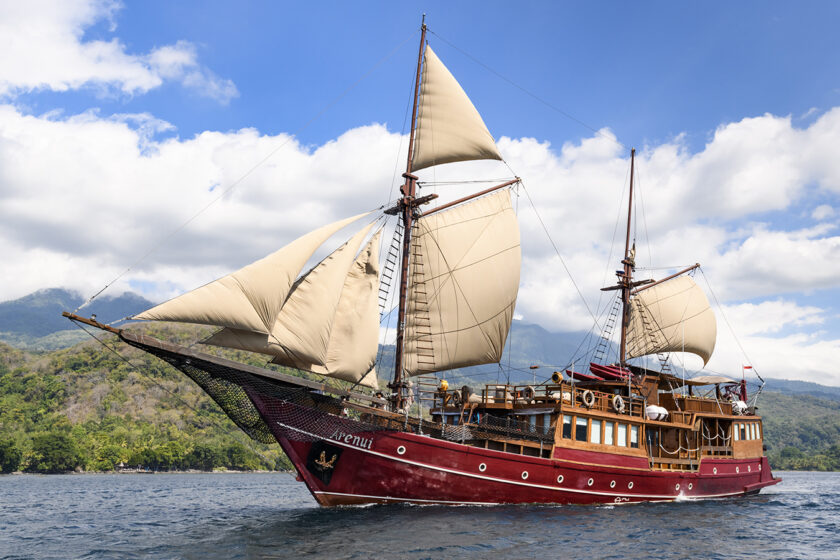It was day six of a nine-day trip aboard the dive liveaboard Arenui, and we were back for a night dive at a site inside Kalabahi Bay, on the western end of Indonesia’s Alor Island. As we prepared to roll over the side, we could hear the local village Imam call the faithful to prayer – hence the inspiration for the dive site’s name: The Mucky Mosque.
We dropped onto a seabed of dark sand, rounded river stones and scattered corals, following a steep slope to a depth of 90 feet. Because this site was located right off the beach of the local village there was also a wide assortment of man-made debris, from tin cans and discarded tires to tattered shirts and pants. While far from scenic, this dive offered its own rewards. In a way, we divers could be called the faithful of a different sort, as we had come to the Mucky Mosque in search of unique experiences and rare treasures.
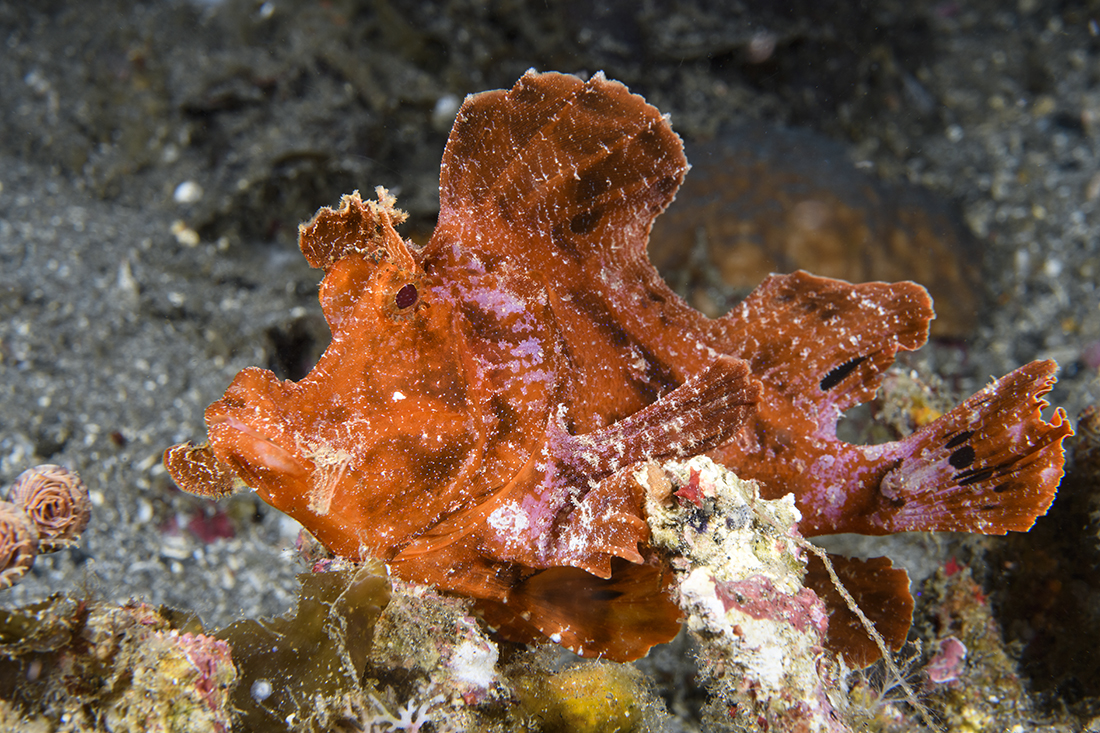
Fifteen minutes into the dive, one of Arenui’s dive guides, Ronald, put me on my second Paddle-flap scorpionfish (Rhinopias eschmeyeri) of the trip; this rather handsome fellow had a deep, somewhat burnt orange, coloration. At the start of this trip, I was promised there would be Rhinopias. Two days earlier we’d found two of these Holy Grail’s of rare reef fish, an orange-hued Paddle-flap (Rhinopias eschmeyeri) scorpionfish seen during an early morning dive, followed by a lavender Lacy scorpionfish (Rhinopias aphanes) discovered that evening on a nearby site. And now, the Mucky Mosque was living up to its reputation. Before the dive was over, we tallied up a few bobtailed squids along with one pygmy squid, a large Spanish dancer, a second orange colored paddle-flap Rhinopias plus a ruby red crocodile snake eel (Brachysomophis crocodilinus) which made for some interesting photos.
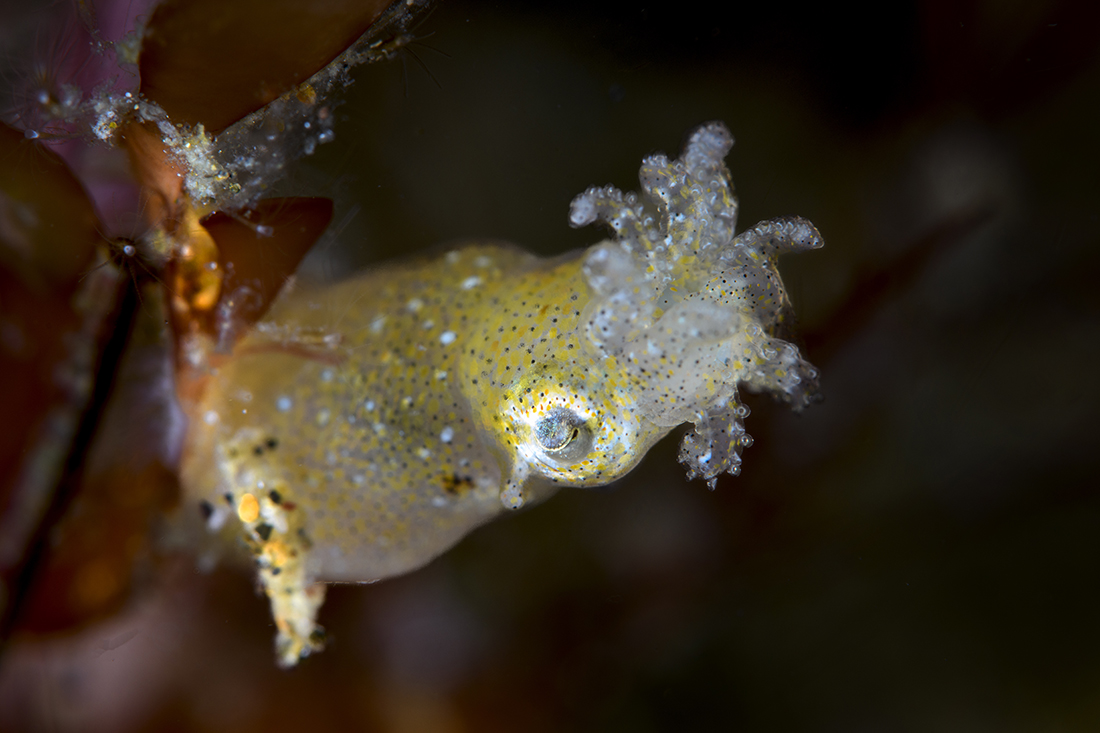
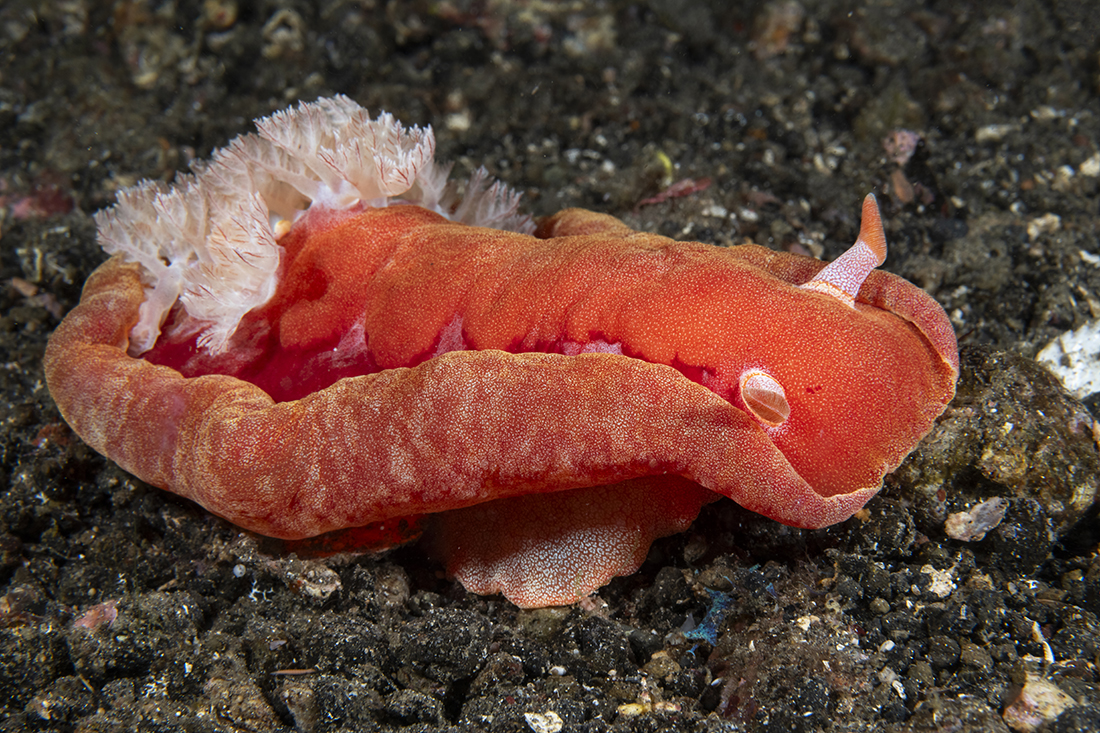
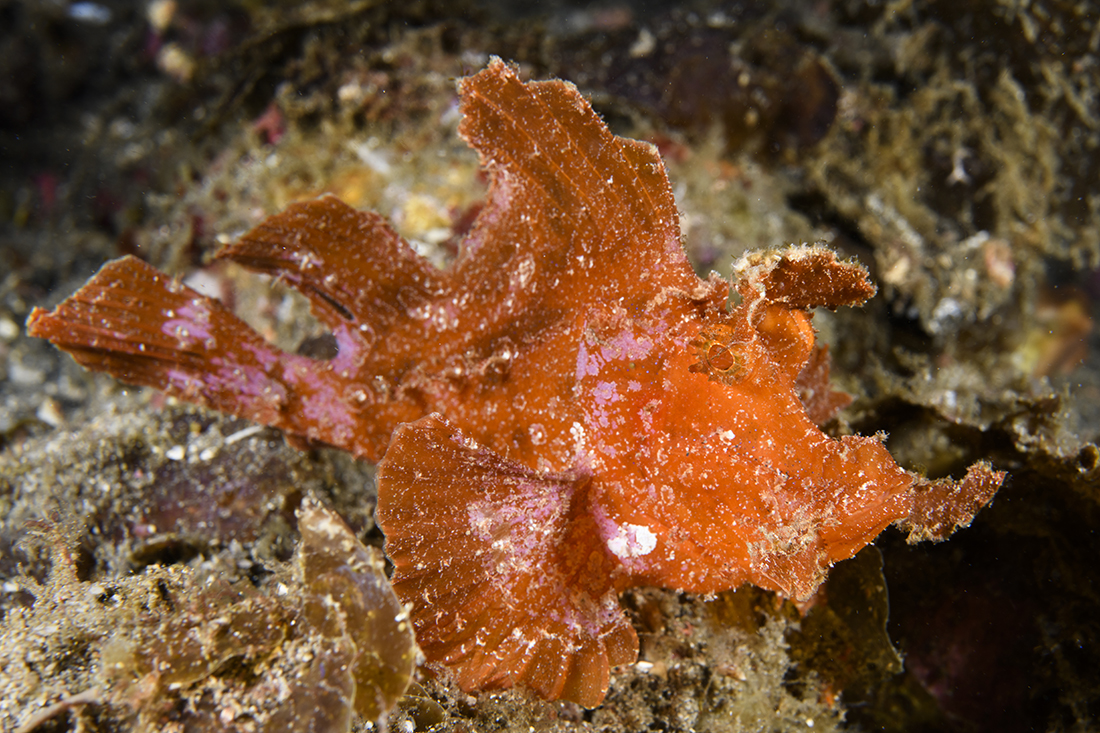
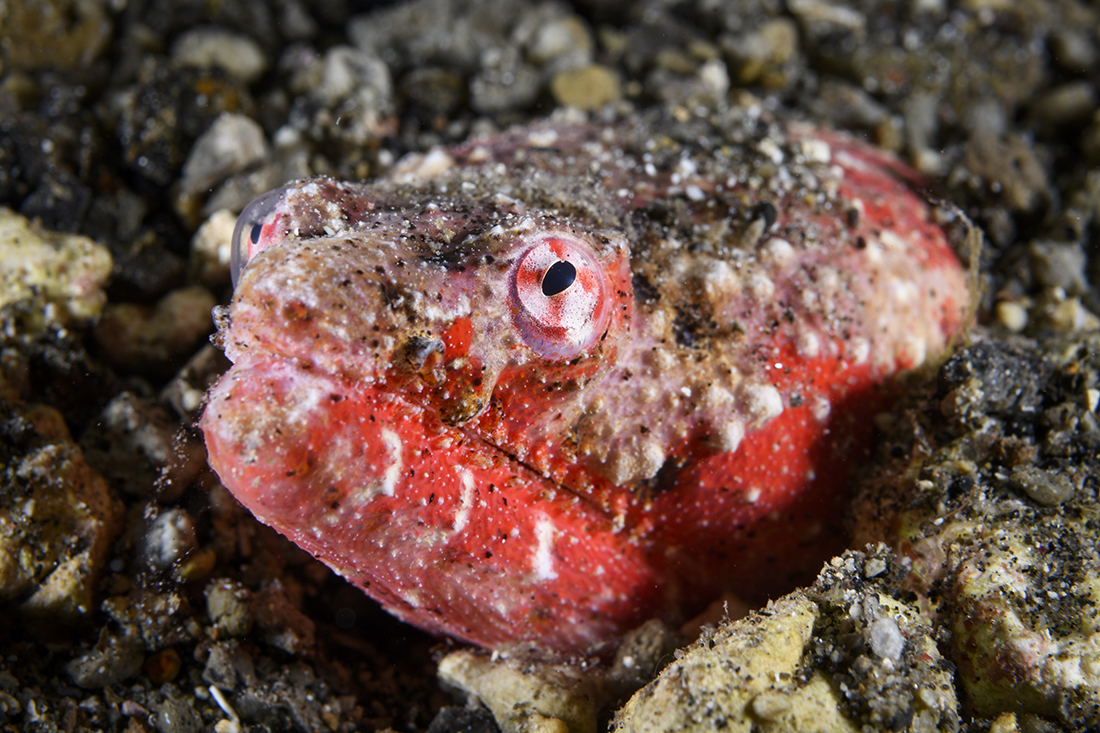
Finding four Rhinopias was just one of the highlights of diving in Alor. And making these dives from the Arenui made the trip all the more pleasurable.
Arenui a Splendid “Boutique” Liveaboard
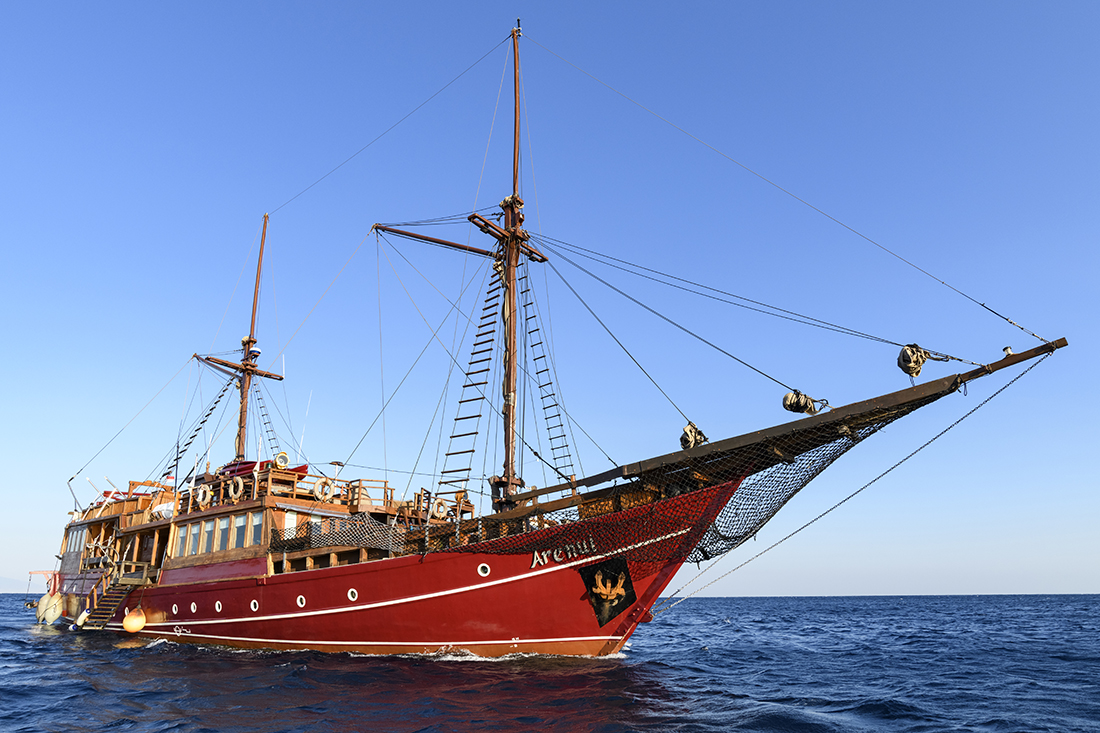
The team at Arenui describes the boat as a “Boutique Liveaboard.” After spending time on board, I think of it as a floating work of art. At 142 feet in overall length, the Arenui has the look of the twin-mast Pinisi-rigged sailing ships once commonly found throughout Indonesia. Minus her regal bowsprit, the Arenui’s actual hull length is about 100 feet, with a copious 30-foot beam and a displacement of close to 300 tons. This substantial vessel is constructed with over 12 different kinds of hardwood, and 75 percent of this material was reclaimed from older wooden ships. The carpentry throughout – from the below-deck cabins to the sundeck – is magnificent and rock solid. The Arenui may look like a sailboat, but she’s not. The sails are purely for show. Arenui’s main propulsion is a single 440-hp Mitsubishi diesel providing her with a top cruising speed of 8 to 10 knots.
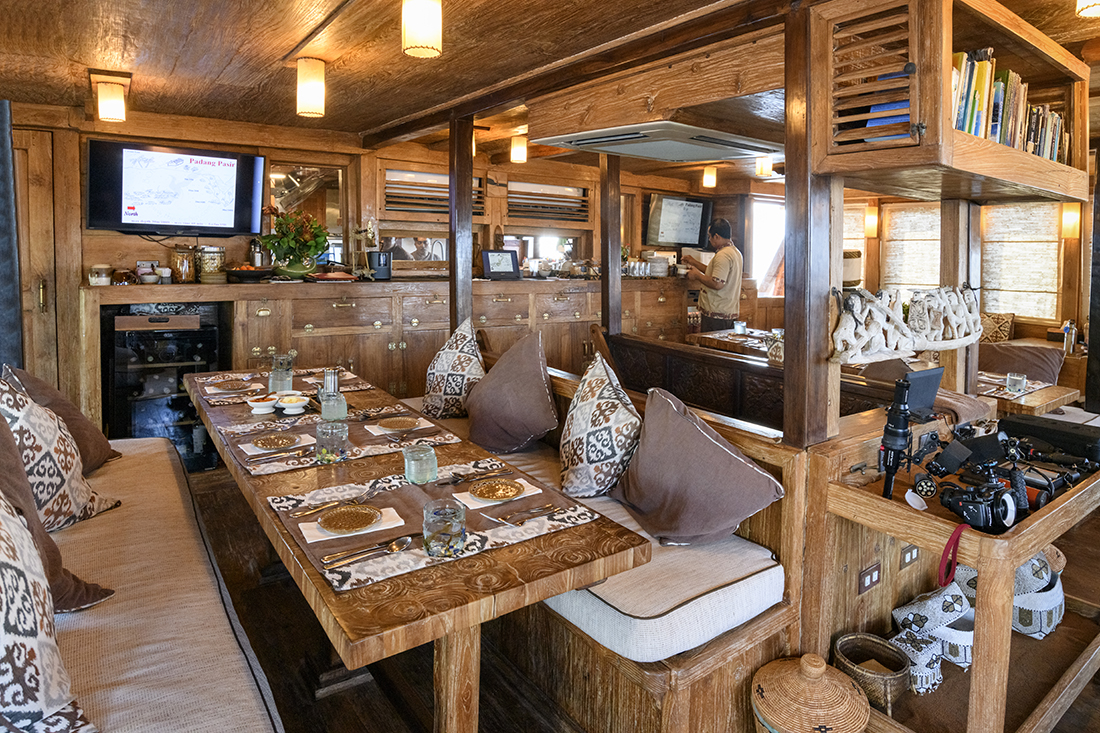
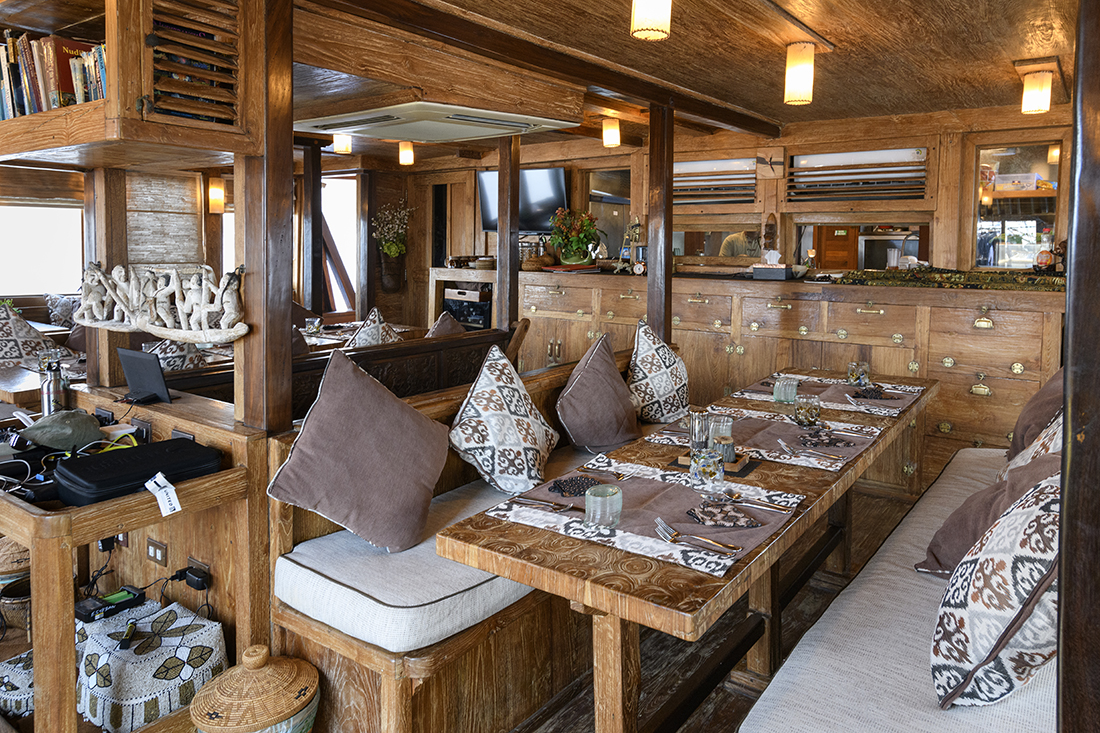
The Arenui’s main dining salon.
The Arenui’s interior showcases rich floor-to-ceiling woodwork that creates a warm, soothing interior atmosphere. Polished brass handles, drawer pulls, and latches on cabinetry and doors complement the look, while portions of the walls are inlaid with eye-catching, intricate carvings depicting various scenes of Ramayana, which is an important part of the Hindu faith. Guest accommodations include four upper-deck and four below-deck cabins named after various Indonesian deities and cultural references. The upper deck cabins have large windows, while the below deck cabins have two small port holes.
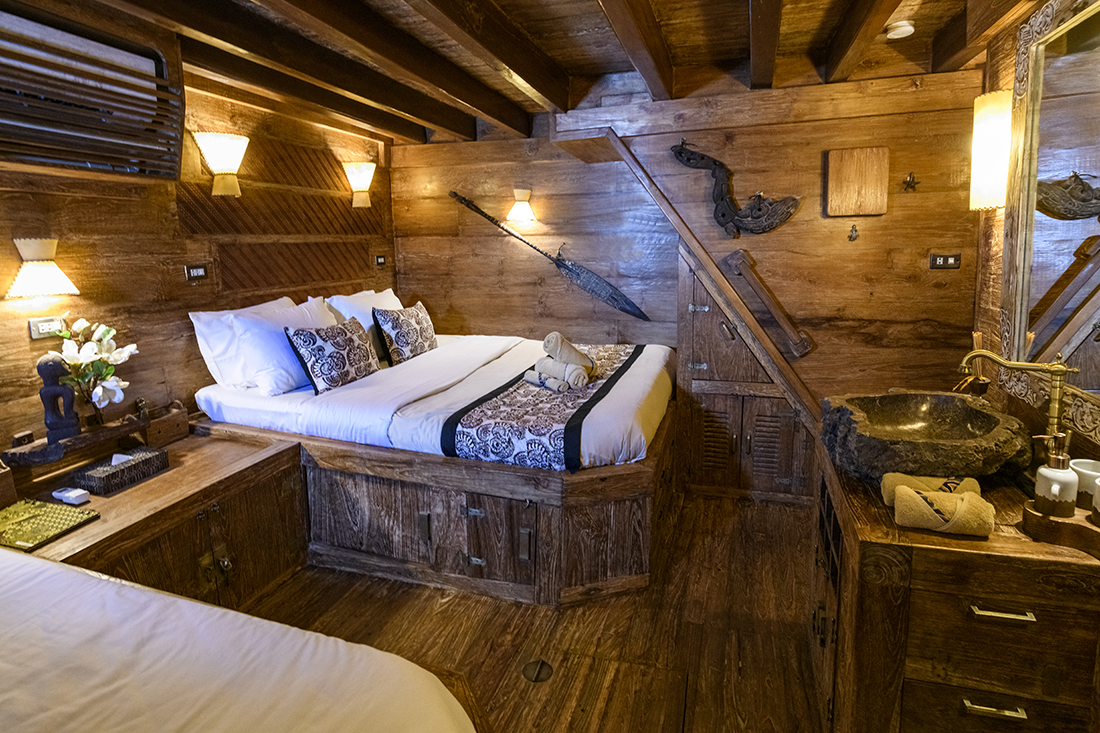
Staying in one of the below-deck cabins was an immense surprise, as it was one of the largest boat cabins I have seen. In addition to a queen-sized bed, there is a second single twin bed plus a vanity with a stone sink basin. All this with plenty of room to move about. The ensuite shower features both a rain showerhead and an additional handheld shower head. If you are looking to cut weight from your luggage, all cabins are supplied with a pleasant body wash, shampoo and conditioner in the shower, and a hair dryer.
Similar attention to the small details extended to all aspects of the onboard experience, and the Arenui even provides guests with a complimentary 30-minute massage during the trip. Laundry service is offered for a small fee, so you can get the clothes you wore during your long flight to Indonesia back clean for the flight home.
While it might be a dive yacht in some of the most remote regions of Indonesia, you will find you are not completely off the grid as Arenui is equipped with a satellite phone, though the $5 USD per minute fee would probably deter long conversations. That said, cell phone service is available while on board in a surprising number of places in Alor and Komodo.
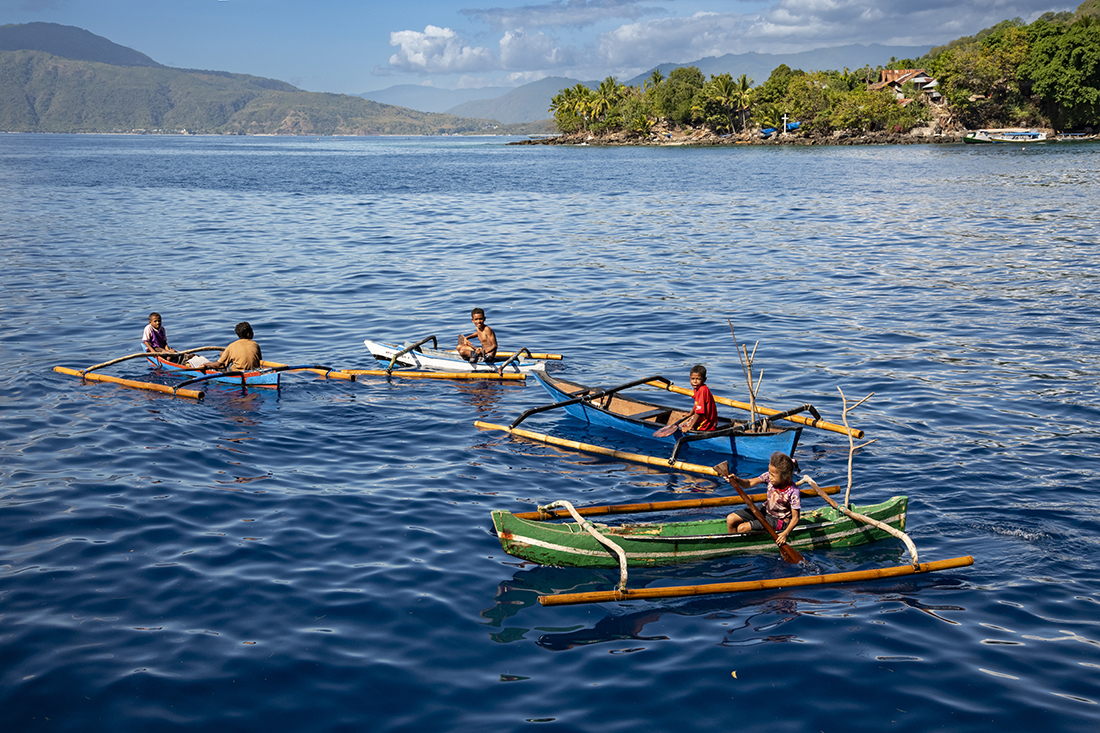
Trips aboard the Arenui begin at East Nusa Tenggara Island in the Flores Island Group. From this central starting point, the vessel cruises either west toward Komodo or east to the islands of Adonara, Lembata, Marisa and Alor. Distances between these islands are significant, so Arenui generally reserves those crossings for nighttime to avoid interfering with the daily schedule of three daytime dives and one night dive. My time aboard took us on the eastern route.
Arenui’s dive Itinerary includes three 60-minute day dives and one night dive at 5:30 pm, which is after sunset in this region. Diving is done from two 21-foot skiffs powered by twin outboard motors. In addition to standard aluminum 80cf tanks, the dive locker has a few 62s and 100s on hand. The boat utilizes two Bower compressors with a membrane system, so the choice is air or 32 percent nitrox. Given the number and duration of each dive, paying the extra $200 USD fee for nitrox is well worth it.
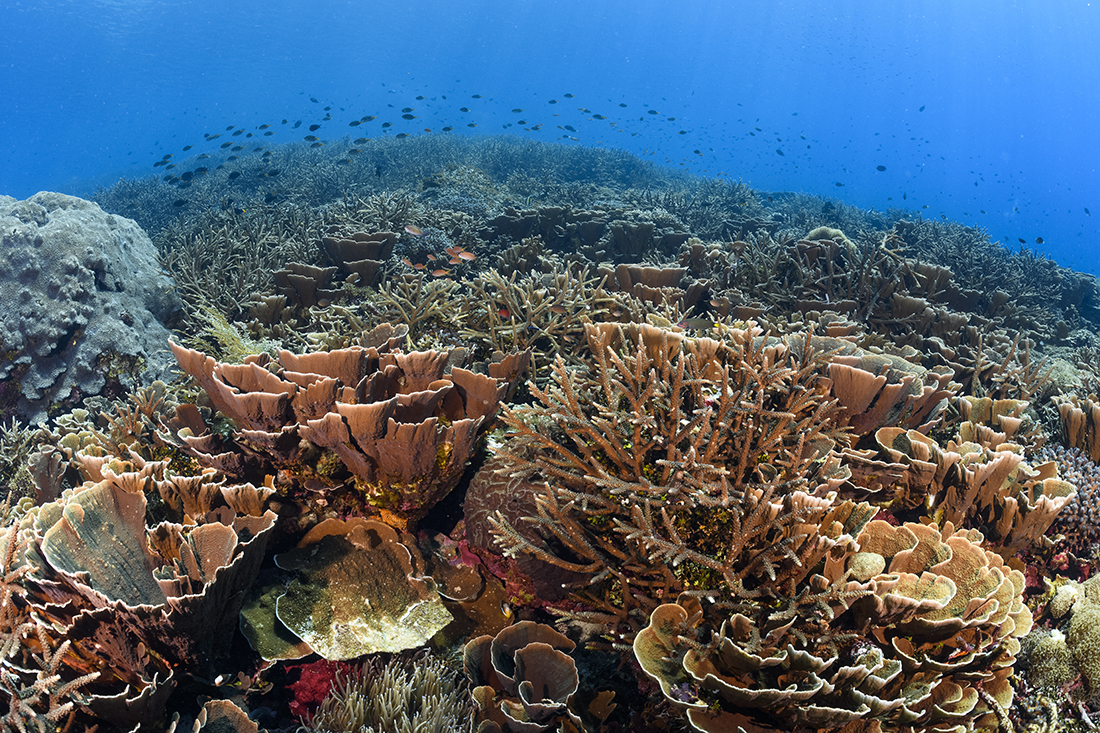
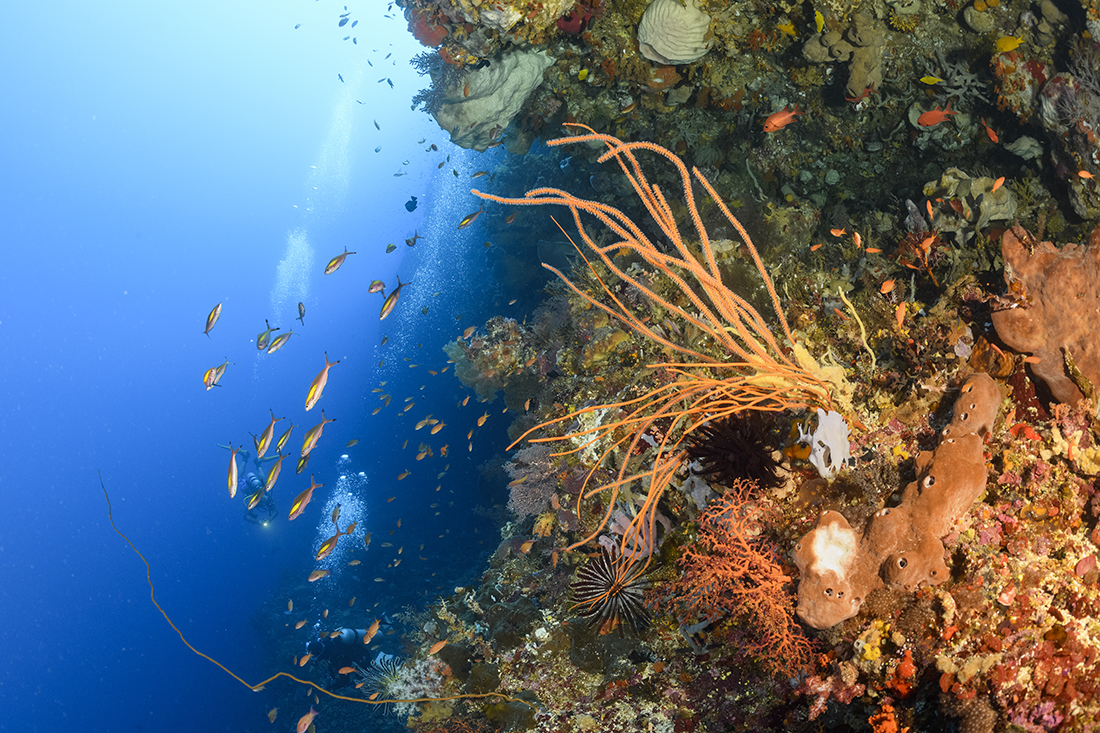
Underwater seascapes in this region typically feature slopes laden with hard corals that drop to depths the surface to depths below 100 feet, or short slopes that transition to walls beginning at 30 to 60 feet. Inside smaller bays, the bottom terrain almost always follows a steep grade downward much like Mucky Mosque, the site mentioned earlier.
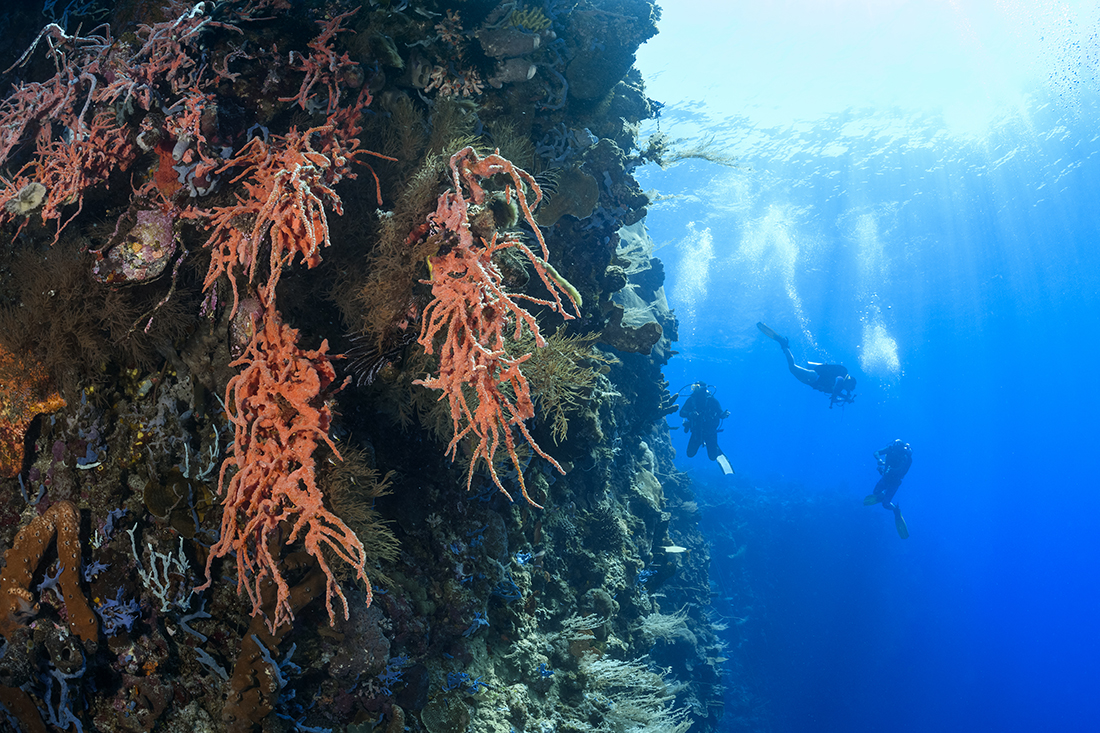
Two sites In Lewoleda Bay illustrate the typical reef profiles of the region. An initial visit to Padang Pasir showed what to expect, with an expanse of white sand bottom and scattered heads of coral that divided two reef fronts. One reef face had a consistently sloping profile, while the second started as a slope that transitioned to a mini wall. The nearby site of Tanjung Bacatang is a wall that drops from around 20 feet straight down to 120 feet, with the face of the wall pockmarked with crevices and ledges adorned with soft corals, sea fans and large sponges.
Returning to Padang Pasir for a night semi-muck dive served up a list of small, interesting critters. Zig-zagging our way across beige sand and inspecting each rock or debris along the way revealed among other things a tiny cockatoo waspfish, two bobtail squids, candy crabs hiding in the soft coral, a blue-ribbon eel in the full adult shades of blue and yellow, one small, black frogfish along with a stargazer, which failed to successfully conceal itself in the sand. Quite an assembly for one dive!
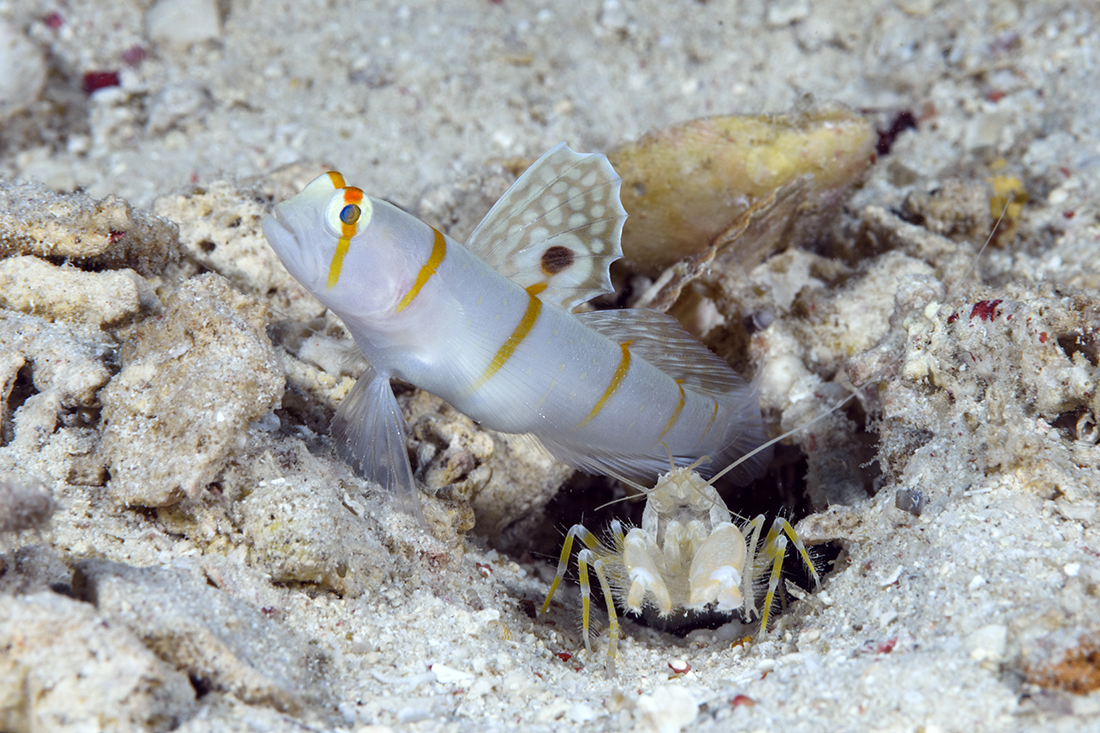
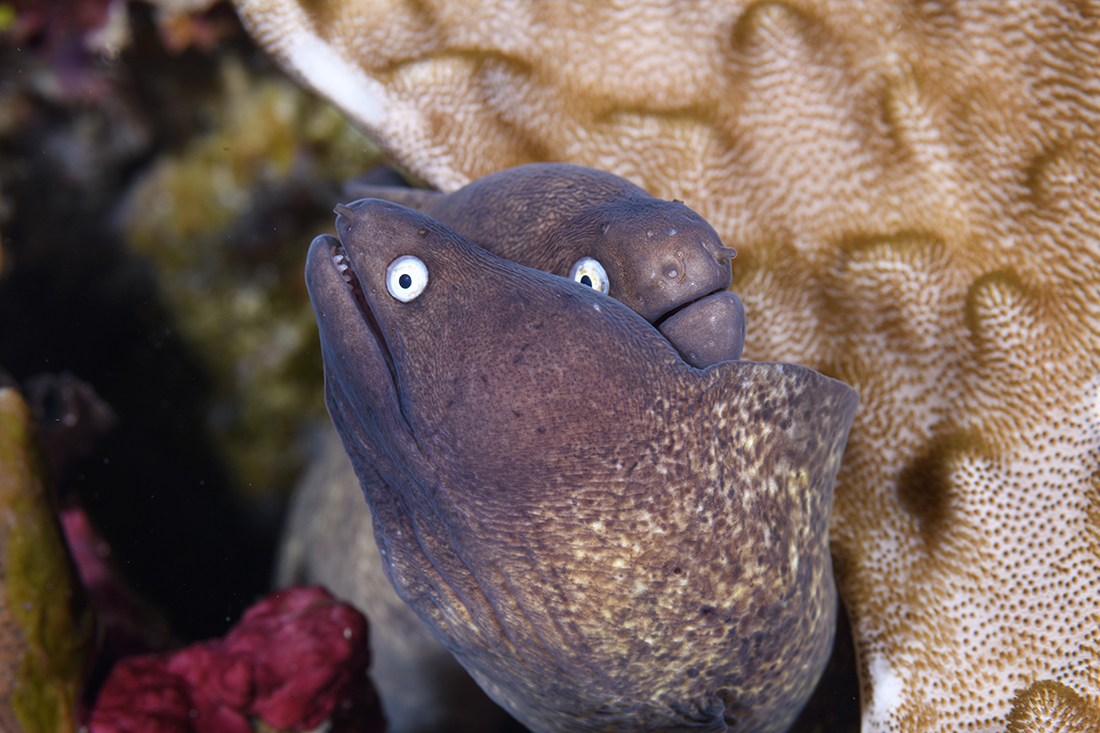
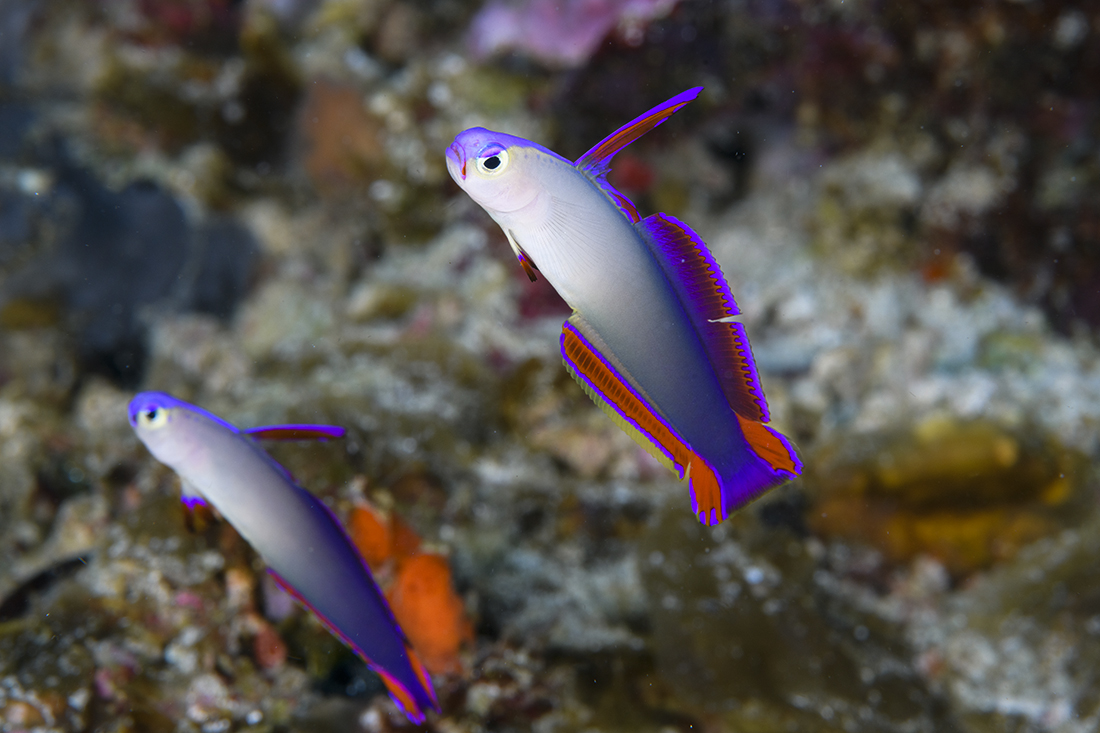
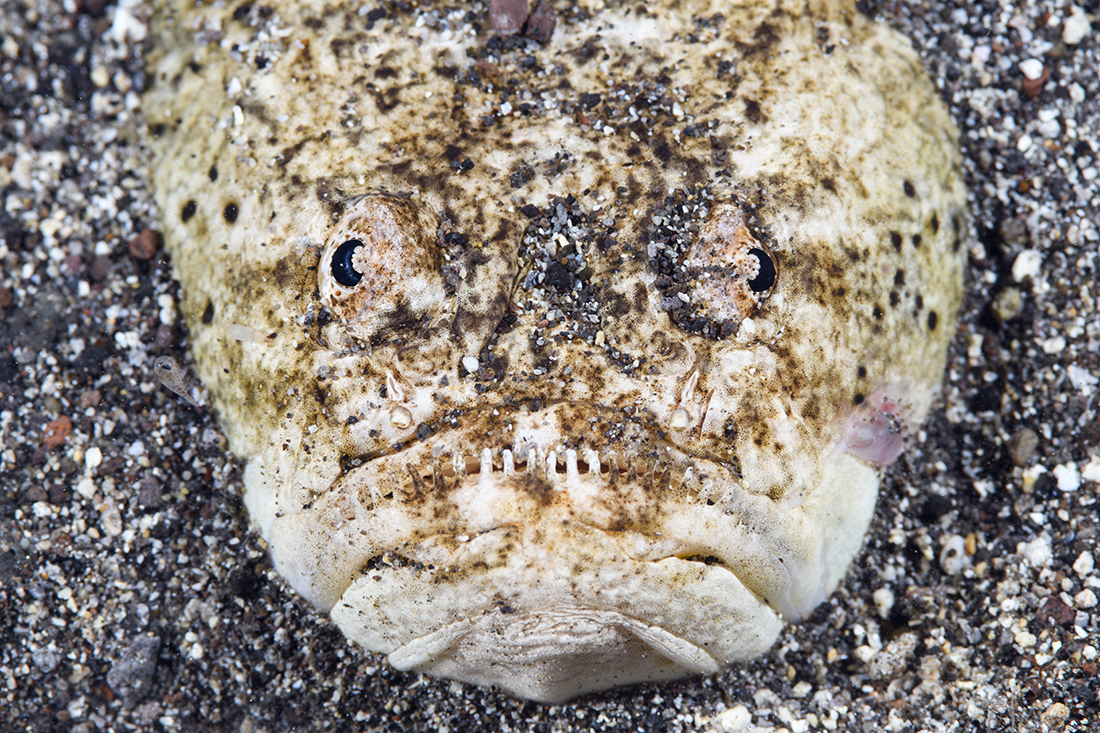
Clockwise: Shrimp gobies like this Randall’s shrimp goby (Amblyeleotris randalli) with its almost matching color Alpheus shrimp roommate are certainly one of the ocean’s genuine odd couples. One stands watch, basically doing next to nothing, while the other does all the house cleaning. Appley named white-eyed moray (Gymnothorax thyrsoideus) these two were getting a bit friendly. Next, a pair of decorated dartfish (Nemateleotris decora). And last the weird face and grimace that only a stargazer can have.
By the fourth day of the trip, we had reached the small volcanic island of Palau Pura in the straits between Pantar Island and the western side of Alor. This area includes the region’s best-known dive site, Clown Valley, also known as Anemone City. Our itinerary didn’t include a stop, however, as I learned that sometime during the past two years, the massive colony of anemones that once populated the site had disappeared.
But even without Clown valley, Alor’s Pantar Straits region delivered rewards at sites with profiles ranging from easy sloping reefs to dramatic shear drop-offs. Where the island’s shoreline juts outward creating a Tanjung (Indonesian for corner) tidal currents can turn swift, as I found out at a site called Three Crosses off Pantar Island. This site’s name comes from a trio of crucifix statues erected on shore right above the corner section of the island. Based on the vigorous currents that wash over the reef, ‘Holly Mother of Tanjungs’ might have seemed more appropriate.
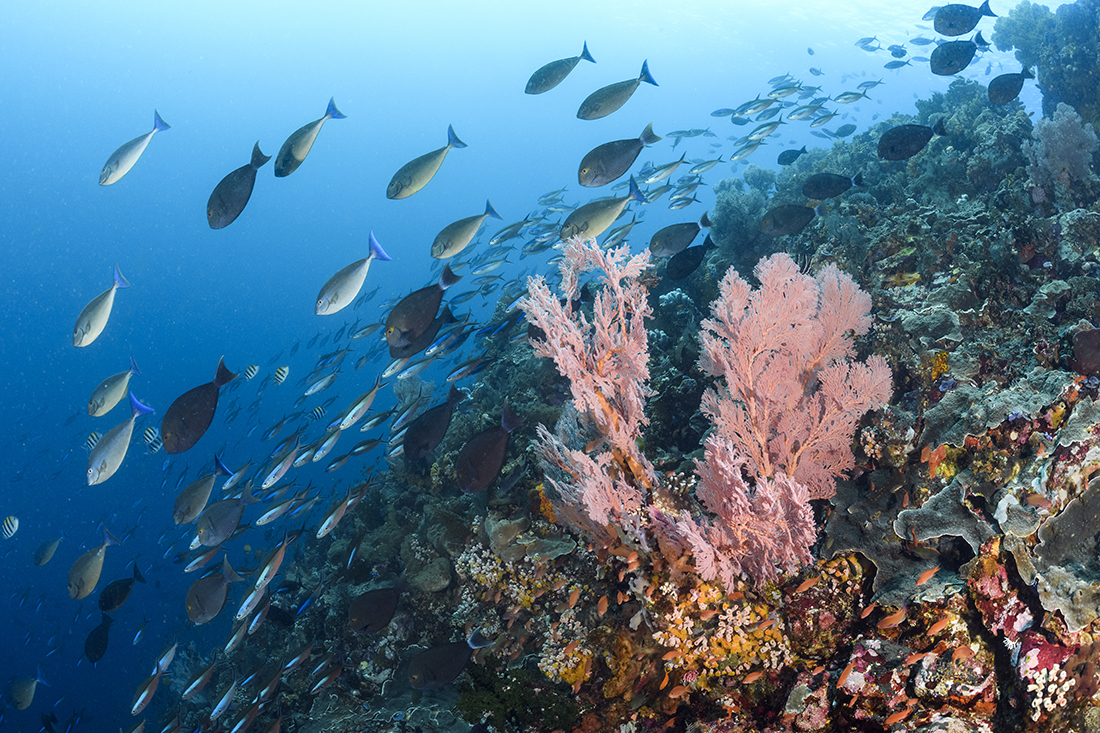
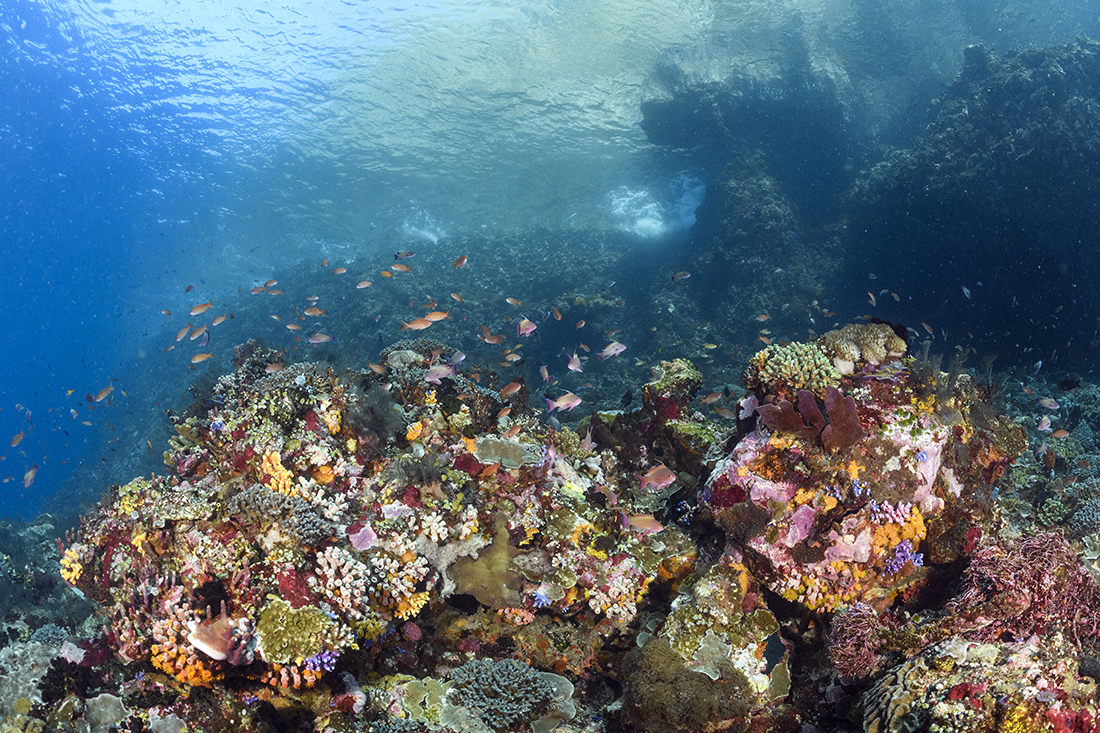
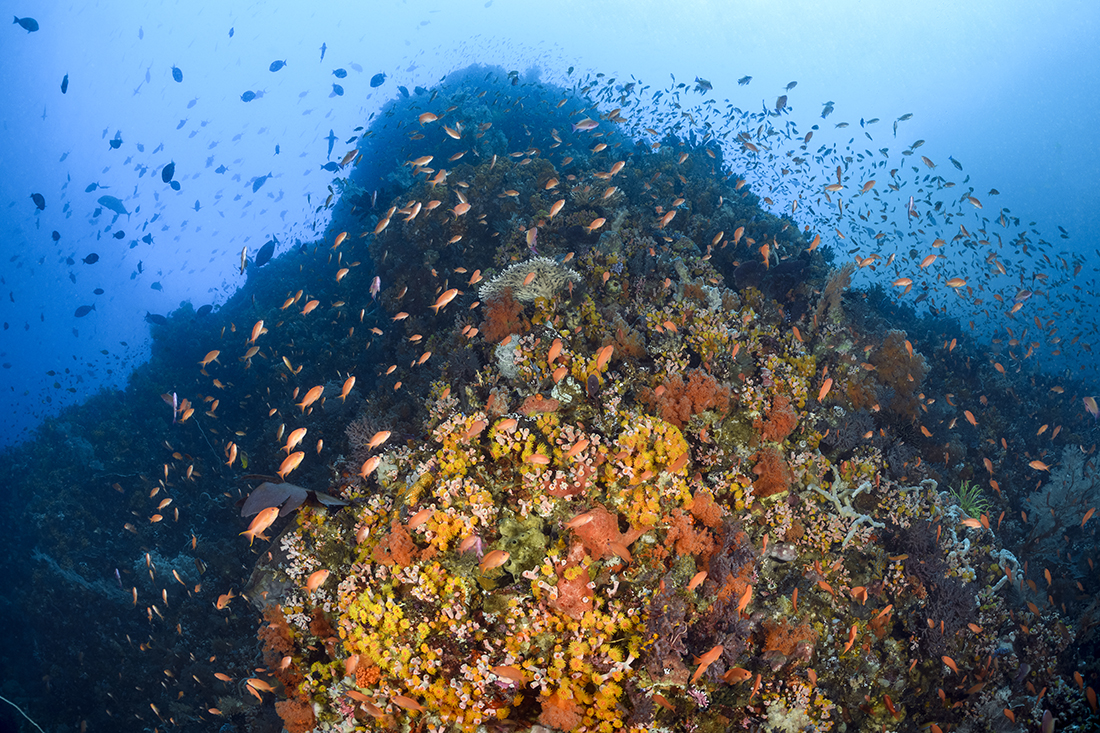
But currents notwithstanding, Three Crosses was one of my favorites as it was as lively as it was beautiful. Here the reef shows more of the island’s volcanic origin more clearly. Steep profiles start at the surface and take dramatic downward turns punctuated with large buttresses of rock that create an obstacle course of sorts that amplifies the currents flow in one place while affording a lee shelter in another. From top to passing the 100-foot mark, almost every square inch of the volcanic rock is covered in various species of encrusting corals and sponges, complemented by clouds of colorful anthias. Adding energy to the scene were schools of fusiliers, triggerfish and jacks in a constant state of motion.
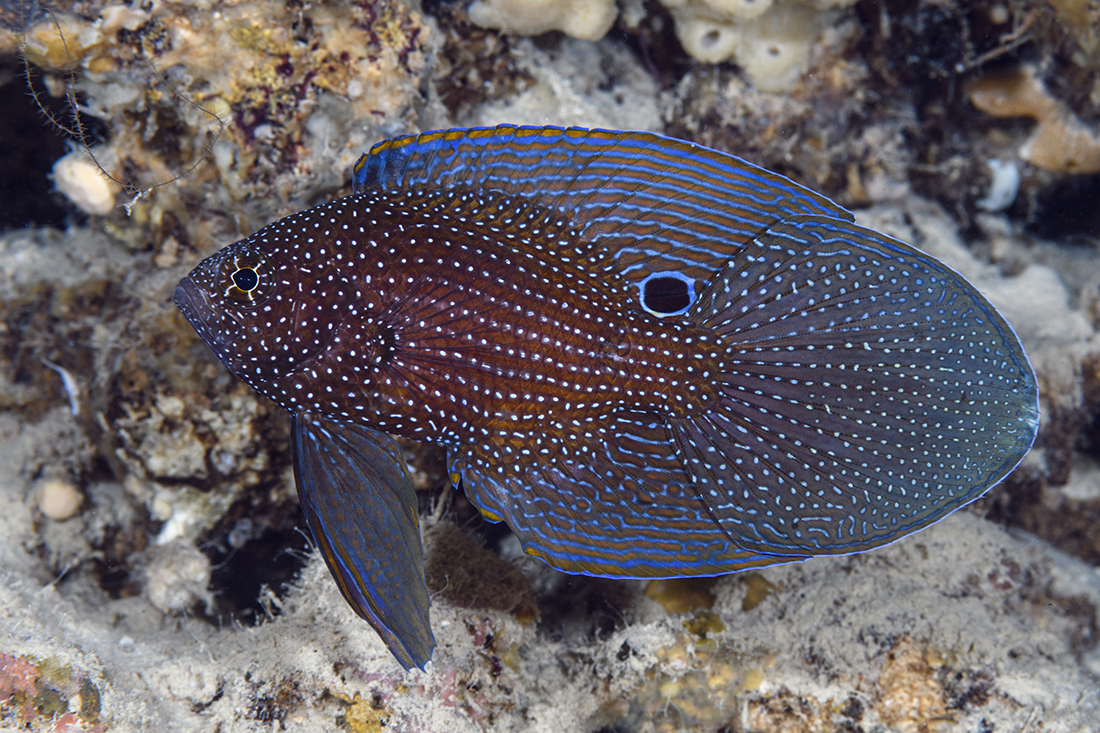
Another highlight of the trip was Reta Wall near Yan Village on Pura Island. Here, the reef began as a shallow hard coral garden densely populated with staghorn and tabletop corals that ran from shore to depths of 30 feet before taking a vertical descent. Below the edge, the wall was well-decorated with soft corals and sponges all the way down to a second shelf at 100 – 110 feet.
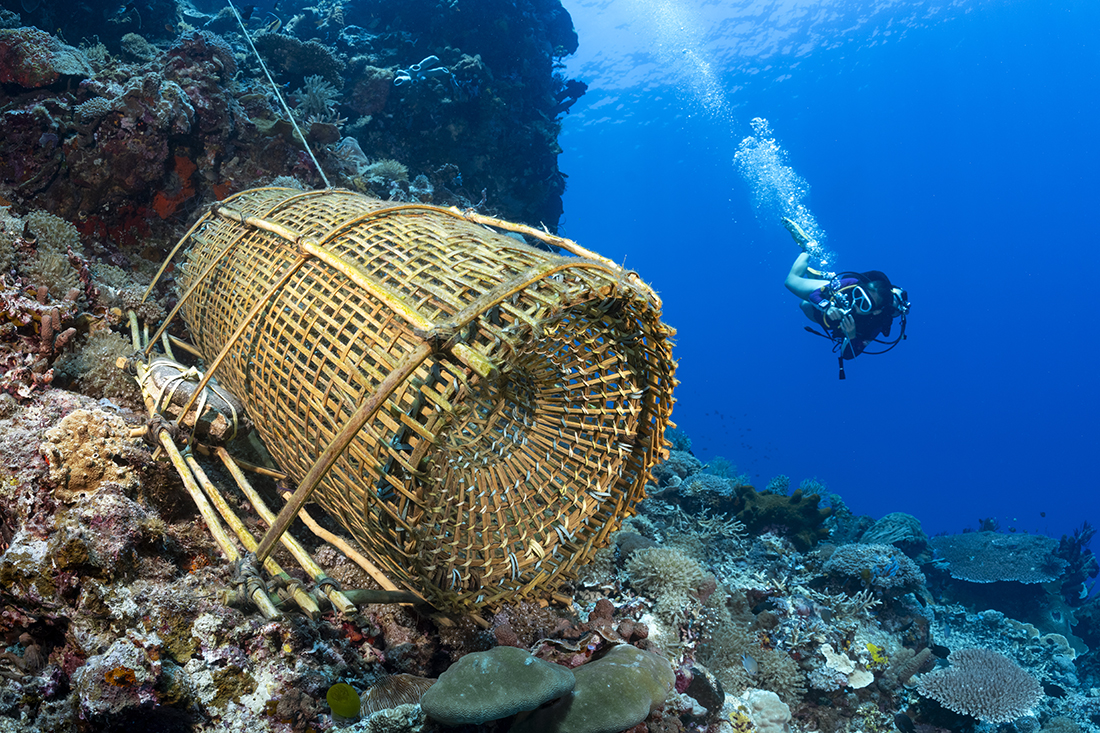
The nearby shores of Yan Village turned out to be an excellent muck dive. Referred to as Yan’s Muck, the site offered a mix of khaki-colored sand, rubble, scattering of small hard corals and sponges scattered across a valley-like profile that begins at 10 feet and bottoms out down past 70 feet. Among many other critters I found here was a brilliant lavender Lacy Rhinopias (Rhinopias aphanes).
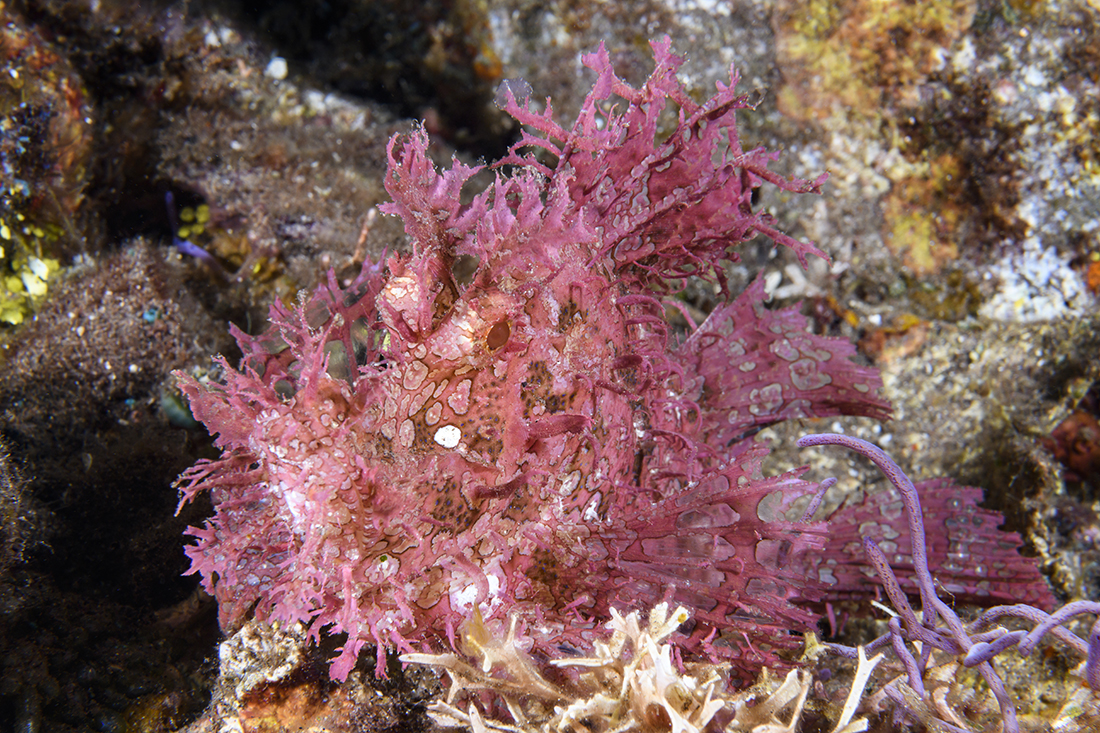
For something different, there was the Frog and Catfish, a large concrete jetty at Pantar Island’s Kadir Village, which was used by local ferries. Diving this site is sometimes dependent on the local ferry schedule and permission from the authorities. The site’s name was derived from the number of giant frogfish and the schools of catfish often found here. During the afternoon dive, got a few choice shots of the concrete support columns decorated with soft corals and sponges and surrounded by a sizable school of spadefish. Coming back to the pier in the early evening produced a variety of nudis, small cuttlefish and crustaceans.
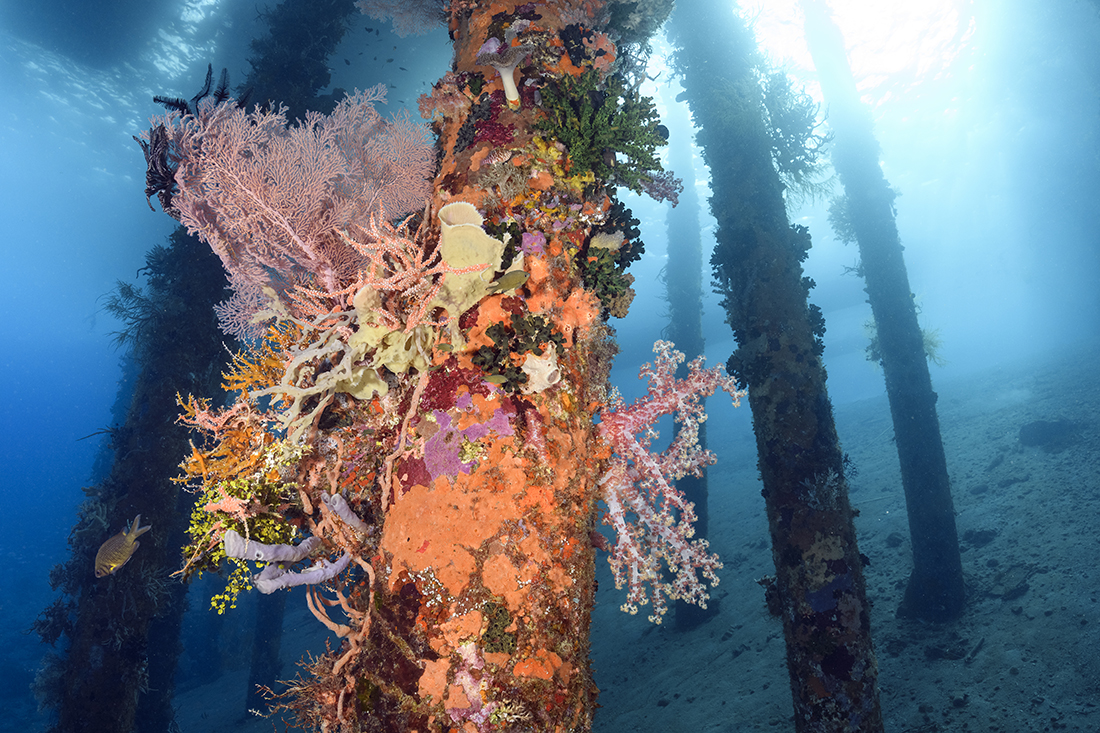
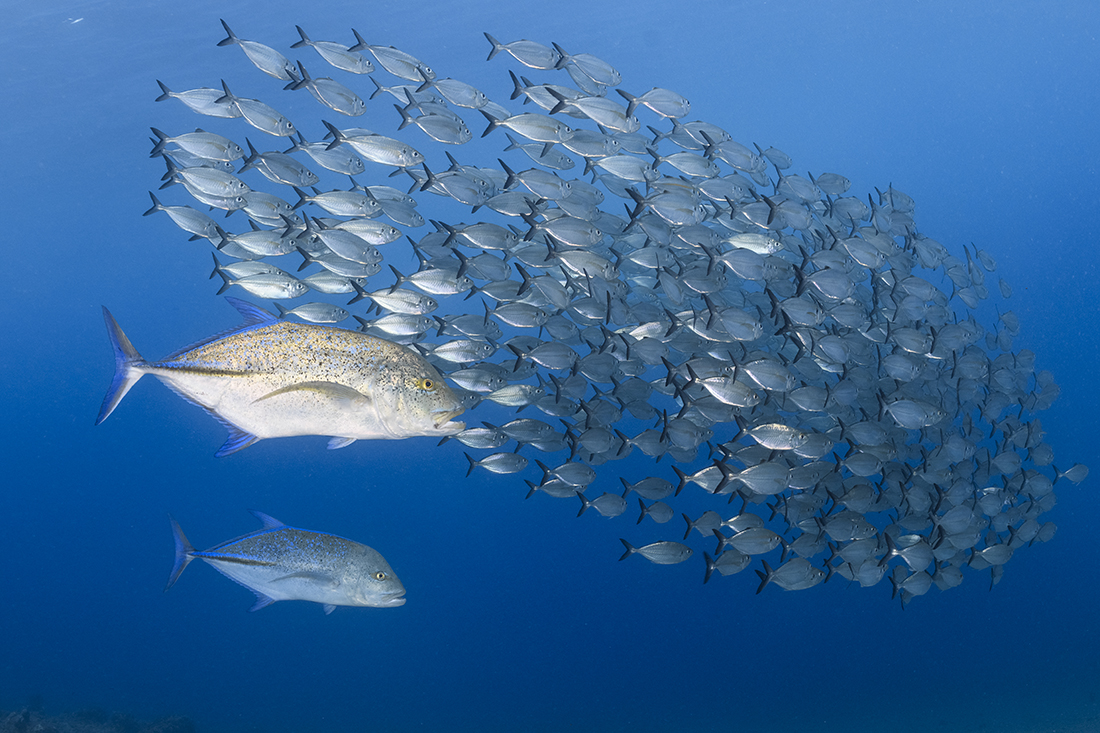
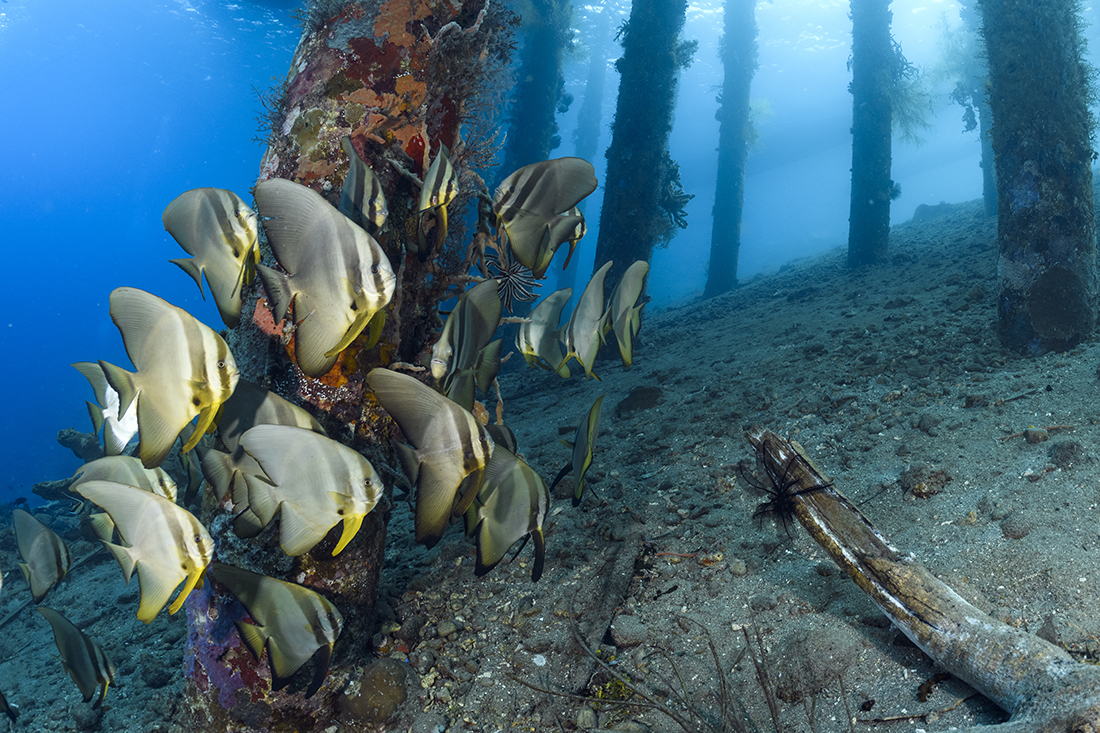
My description so far is a mere taste of the Arenui’s 10 Day / 9 Night Itinerary through the eastern Flores Island group to Alor. I made a total of 29 dives during this trip, and each one was as memorable as the last. Every bit as memorable as the diving was my time aboard the Arenui.
Getting There
Getting to where the Arenui is based during both their Komodo and Alor season requires a short (2-hour-plus) flight from Bali-Denpasar (DPS) to Maumere (MOF) via one of Indonesia’s regional carriers, Lion Air. At the time of my trip in July 2022, there was no direct flight service available to Maumere, which entailed making a stop and plane change in Kupang or Makassar.
Arenui’s office in Bali can help arrange domestic flights in and out of Maumere. Airfare Bali-Maumere-Bali currently starts from USD $420 per person incl. 20kg luggage per person. Additional luggage of 10KG is USD100 and 20KG is USD $200.
For flights entering and departing from Indonesia it is recommended to arrive in Bali at least one full day before the departure flight to meet your Arenui cruise date. Aernui’s office can also help with a hotel booking in Bali.
Contact: info@thearenui.com | www.thearenui.com

